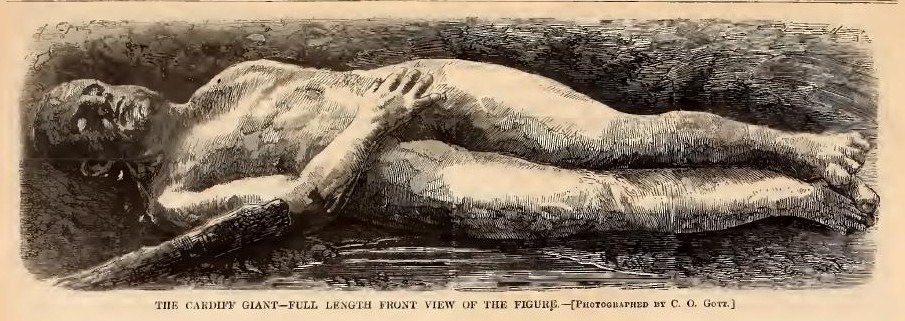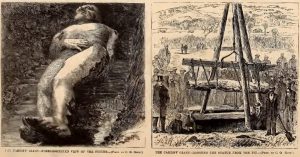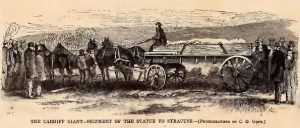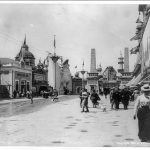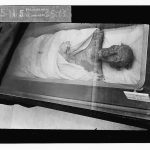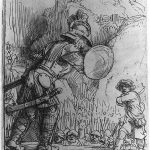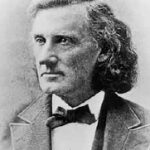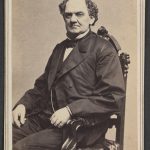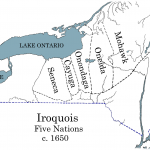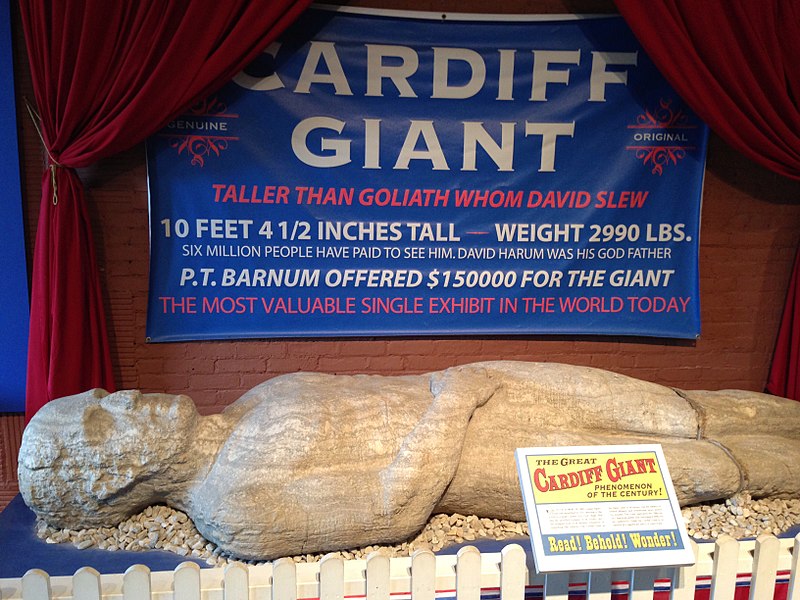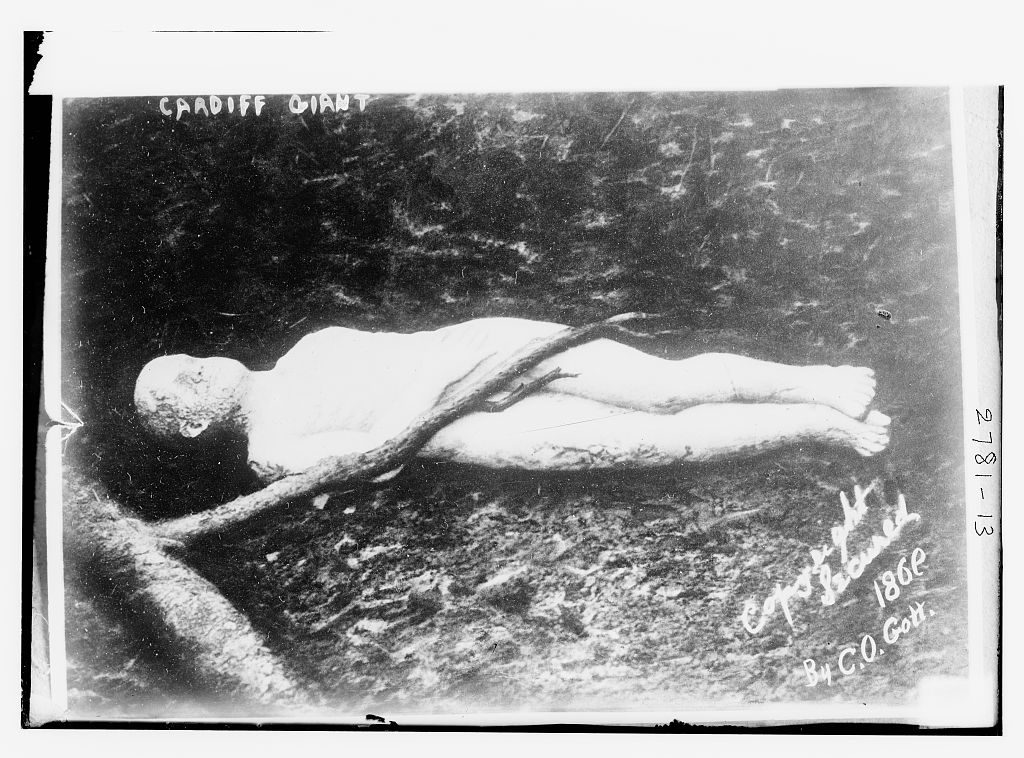Not exactly a mummy just in time for Halloween, but in October 150 years ago some folks south of Syracuse, New York dug up what appeared to be a well-preserved human being. The mysterious form didn’t seem to be preserved by mummification but by petrifaction – the process of organic matter turning to stone. And it wasn’t just any human being, it was a giant of a man, over ten feet tall! The find generated a lot of interest; it didn’t take long for a geologist who examined the object to determine that it had never been a living, breathing human, it was just a well-wrought statue.
From the December 4, 1869 issue of Harper’s Weekly:
THE CARDIFF GIANT.
On the 16th of October there was discovered on Mr. NEWELL’S farm in Onondaga County, New York, and about thirteen miles south of Syracuse, what what at first was supposed to be a petrified human form – a giant of the olden time. The first reports of this discovery excited the greatest interest among all classes, and especially among scientific men. The fossil was found about three feet below the surface while some persons were digging for a well.The soil was a sort of bluish [?] clay mixed with quicksand [?] and black loam, and organic remains were found about the body. The figure, when first discovered, lay in a very easy and natural position, horizontal, partly on the right side, with the right hand resting over the abdomen. It’s dimensions were as follow [sic]: From crown of head to hollow of foot, 10 feet 2 1/2 inches; crown of head to tip of chin, 1 foot 9 inches; length of nose, 6 inches; width of nostrils, 3 1/2 inches; width of mouth, 4 inches; point to point of shoulder, 3 feet; point of hip to knee-joint, 3 feet; diameter of calf of leg, 9 1/2 inches; diameter of thigh, 1 foot; length of foot, 1 foot 7 1/2 inches; width of palm, 7 inches; diameter of wrist, 5 inches. The veins, eyeballs, muscles, tendons of the heel, and cords of the neck were all fully disclosed.
As we have said, this figure was at first supposed to be a petrified human form. But it was soon found that this theory seemed hardly plausible. Though the figure had the appearance of stone, the outer surface could be shaved off with a knife without dulling the blade. Dr. J.F. BOYNTON visited the figure, and, after a careful examination, pronounced it to be a statue of a Caucasian. The features were finely cut, and excellent artists have remarked the symmetry of proportions characterizing the whole figure.
Dr. BOYNTON at first supposed that this statue was carved by the Jesuits who dwelt in this valley between 1520 and 1760. After a more thorough examination he declares it to be of gypsum, and of recent origin. He says, in a recent letter to Professor SPENCER, of the Smithsonian Institute, at Washington:
“I have stated that I thought his ‘origin would not carry us back over three hundred years;’ but I am not certain that the known principles of chemistry will justify me in asserting that the period between his burial and resurrection was over three years. Its antiquated appearance has been produced not by abrasion, as many have said, but by the dissolving action of water, which, I think, could have been accomplished in a few months. A more careful and accurate calculation, admitting the possible chance of some undiscovered error creeping into the calculation, may show the burial to have taken place about 370 or 371 days ago – as it may have happened between two days.”
Mr. NEWELL, upon whose ground the statue was found, is said to have disposed of it for $40,000. The figure has been carried to Syracuse. Its weight is 2990 pounds. If it were solid stone it would not weigh so much by 500 pounds. A recent theory has been started, that it is a cast-iron figure covered with a coating of cement. The head, it is said, gives a ringing sound when struck, like that of a hollow, metallic body. But Mr. PALMER, the sculptor, states that there are marks of sculptor’s tools.
American Goliah, a pamphlet published shortly after the find (and republished at Project Gutenberg), included a letter from Dr. Boynton explaining his raionale for concluding that the object was not a fossil-man. But the pamphlet also included reasons to think it might have been petrified and included the contrasting opinions of Tom, Dick, and Harry. A letter to the editor explained that the Onondaga people believed the giant was the prophet who predicted long ago the coming of the pale-faces and that he would die and be buried but that later Onondagas would see him again. It seems that the pamphlet was published before the move to Syracuse – hackies were available to drive visitors from Syracuse to the site; “The average daily attendance for the first week was from three to five hundred persons.” The big thing inspired scientists to examine but also artists to write:
TO THE GIANT OF ONONDAGA.
Speak out, O Giant! stiff, and stark, and grim,
Open thy lips of stone, thy story tell;
And by the wondering crowd who pay thee court
In thy cold bed, and gaze with curious eyes
On thy prone form so huge, and still so human,
Let now again be heard, that voice which once
Through all old Onondaga’s hills and vales
Proclaimed thy lineage from a Giant race,
And claimed as subjects, all who trembling hear
Art thou a son of old Polyphemus,
Or brother to the Sphinx, now turned to stone—
The mystery and riddle of the world?
Did human passions stir within thy breast
And move thy heart with human sympathies?
Was life to thee, made up of joy and hope,
Of love and hate, of suffering and pain,
In fair proportions to thy Giant form?
Did ever wife, by whatsoever name
Or tie of union, with her ministries
Of love, caress and cheer thy way through life?
Were children in thy home, to climb thy knee
And pluck thy beard, secure, and dare thy power
Or, was thy nature as its substance now,
Like stone—as cold and unimpressible?
Over these hills, with spear like weaver’s beam,
Dids’t thou pursue the chase and track thy foe,
Holding all fear and danger in contempt?
And, did at last, some fair Delliah
Of thy race, hold thee in gentle dalliance,
And with thy head upon her lap at rest,
Wer’t shorn of strength, and told too late, alas,
“Thine enemies be upon thee?”
Tell us the story of thy life, and whether
Of woman born—substance and spirit
In mysterious unon [union?] wed—or fashioned
By hand of man from stone, we bow in awe,
And hail thee, GIANT OF ONONDAGA!
SYRACUSE, Oct. 20, 1869. D.P.P
“Tell us the story of thy life”? Well, it seems that the mystery man is still speechless, but Wikipedia explains that the Cardiff Giant was a giant hoax. Atheist George Hill wanted to have some fun with believers who read the Bible literally – Genesis 6:4 says that giants once lived on earth. P.T. Barnum was so enamored with the profit-making potential of the object he offered $50,000 for it; rebuffed, Mr. Barnum commissioned a plaster replica he showed off as the original fossilized man and claimed the specimen unearthed in the hamlet of Cardiff was the actual imposter.
The first scientist on the scene, John F. Boynton, was an early leader in the Mormon Church, who was later excommunicated. He seemed to have a wide range of scientific interests. “After parting ways with the church, Boynton traveled throughout the United States lecturing on natural history, geology, and other sciences. Between 1853 and 1854, he joined a U.S. government geological surveying expedition to California. During the American Civil War, Boynton was employed by the U.S. to design torpedoes and other weapons. He holds 36 patents in the U.S. National Patent Office.”

